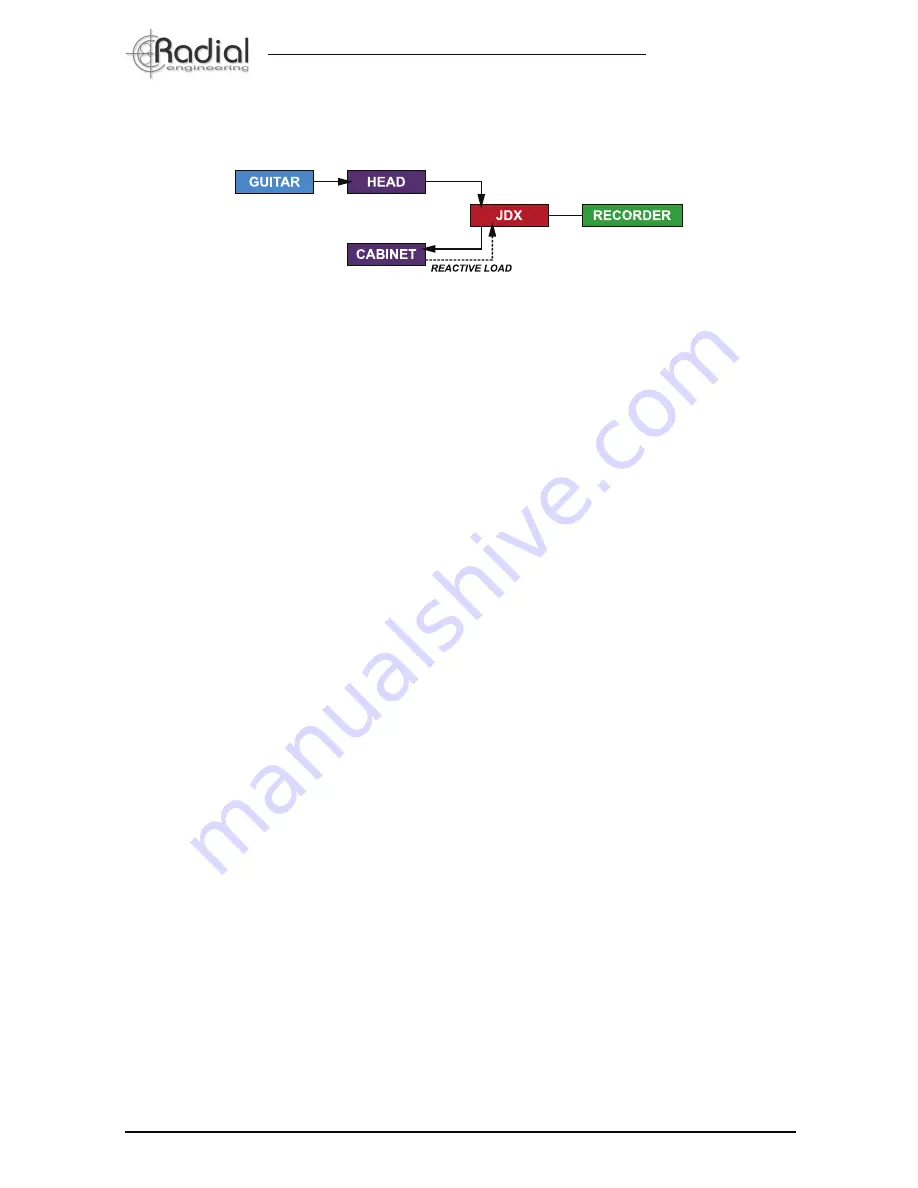
Radial Engineering Ltd.
JDX 500 Module
True to the Music
®
6
Using The JDX In Amp Mode
This set up is designed to record the sound of your guitar or bass using the JDX without a
microphone.
Make sure the GUITAR selector switch is set to the outward position (LED not fl ashing). Plug
your guitar into your amp and connect the head’s speaker output to the JDX, then the JDX
speaker out to your guitar speaker cabinet. Always use heavy 12 gauge speaker cables to
ensure you get maximum signal transfer between the amp head and cabinet. Start by testing
your amp to make sure it is working properly. We always recommend testing at low volumes
for safety. This can save your ears and equipment from damage.
Connect from the JDX to your recording system using the balanced XLR output located
on the rear of your 500 series rack. Start playing. You should be able to hear the sound in
your recording system. If you have a Workhorse, turn on the channel module slot. You can
then monitor it via the headphones or one of the outputs. If you hear any buzz or hum, try
depressing the lift switch. This disconnects the ground connection going to the amplifi er.
Extending the bass -
The JDX is designed to emulate a 4x12 cabinet. Although this may
sound very ‘guitar-centric’, smaller speakers are often used for bass as it allows the sound
to punch through the mix with less of a heavy bottom end. To add versatility, the JDX module
is equipped with a LF-EXT or low frequency extension switch that basically widens the
frequency response and reaches down further to emulate a 15” loudspeaker. This adds an
octave or more to the bottom end to create bigger bass tones. On keyboards, it can be used
to fatten up the low end of a Hammond and with today’s 7-string guitars, you can descend
into the trenches of fi lth and degradation.
Extending the power -
The JDX was originally designed for 100 watt guitar amps. But as we
later discovered, many artists began using the JDX with high-power bass amps causing the
JDX output levels to be signifi cantly greater than with 100 watts amps. As a safety measure
and to reduce the risk of overdriving the output stage, the JDX module has been outfi tted
with a 300W switch. This introduces an attenuating pad at the ¼” HEAD input to lower the
sensitivity.
Playing in phase -
Another cool feature on the JDX is the 180º polarity reverse switch. This
is used when combining the sound from the JDX with a microphone on the speaker cabinet.
Sometimes, by simply reversing the polarity, you can improve the tone dramatically. You can
of course take this to a signifi cantly higher level by adding a PhazeQ to this set up. With the
PhazeQ’s completely variable phase control, you can dial it the perfect tone from mid punch
to major crunch!
The Low Pass Filter -
Once you start listening to the JDX, you will certainly want to tweak
the tone to suit. The variable low pass fi lter is designed to gently roll off top end and smooth
out the tone so that it better replicates the sound of your guitar coming through the amp.
Simply depress the LPF switch and then rotate the TONE SHIFT control counter-clockwise
(starting at 5:00 o’clock) until it sounds right.






























